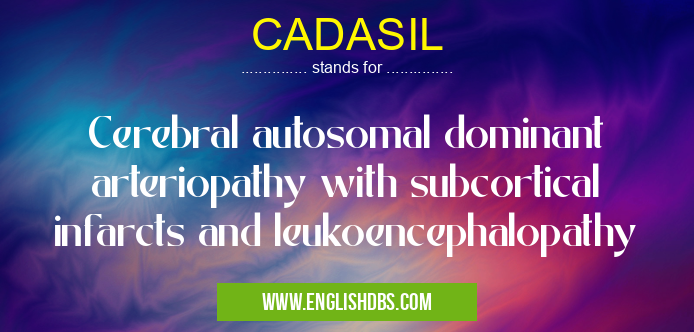What does CADASIL mean in DISEASES
CADASIL stands for Cerebral Autosomal Dominant Arteriopathy with Subcortical Infarcts and Leukoencephalopathy. It is a rare inherited condition that affects the blood vessels in the brain. It is caused by a mutation in the NOTCH3 gene. This mutation leads to the production of an abnormal protein that accumulates in the walls of blood vessels, causing them to narrow and become blocked.

CADASIL meaning in Diseases in Medical
CADASIL mostly used in an acronym Diseases in Category Medical that means Cerebral autosomal dominant arteriopathy with subcortical infarcts and leukoencephalopathy
Shorthand: CADASIL,
Full Form: Cerebral autosomal dominant arteriopathy with subcortical infarcts and leukoencephalopathy
For more information of "Cerebral autosomal dominant arteriopathy with subcortical infarcts and leukoencephalopathy", see the section below.
Symptoms
The symptoms of CADASIL can vary depending on the severity of the condition. Some people may experience only mild symptoms, while others may have more severe symptoms that can be debilitating. The most common symptoms include:
- Stroke
- Migraine headaches
- Cognitive impairment
- Memory loss
- Difficulty with walking and balance
- Depression
- Anxiety
Diagnosis
CADASIL is diagnosed based on a combination of symptoms, a physical examination, and a genetic test. The genetic test can identify the mutation in the NOTCH3 gene that causes the condition.
Treatment
There is no cure for CADASIL, but there are treatments that can help to manage the symptoms. These treatments may include:
- Medications to prevent stroke
- Medications to treat migraine headaches
- Rehabilitation therapy to improve cognitive function and mobility
- Counseling to help with depression and anxiety
Essential Questions and Answers on Cerebral autosomal dominant arteriopathy with subcortical infarcts and leukoencephalopathy in "MEDICAL»DISEASES"
What is CADASIL?
CADASIL (Cerebral Autosomal Dominant Arteriopathy with Subcortical Infarcts and Leukoencephalopathy) is a genetic condition that affects the small arteries in the brain. It is caused by mutations in the NOTCH3 gene. These mutations lead to the production of abnormal NOTCH3 protein, which damages the smooth muscle cells in the walls of the arteries. This damage can cause the arteries to narrow and become blocked, leading to strokes and other neurological problems.
What are the symptoms of CADASIL?
The symptoms of CADASIL can vary depending on the severity of the condition. Common symptoms include:
- Headaches
- Migraines
- Strokes
- Transient ischemic attacks (TIAs)
- Cognitive impairment
- Memory problems
- Mood disorders
- Difficulty walking
- Speech problems
How is CADASIL diagnosed?
CADASIL is diagnosed based on a combination of symptoms, family history, and genetic testing. A doctor may order a brain MRI to look for signs of strokes or other damage to the brain. Genetic testing can confirm the diagnosis of CADASIL.
Is there a cure for CADASIL?
There is currently no cure for CADASIL. However, there are treatments that can help to manage the symptoms of the condition and prevent further damage to the brain. These treatments may include:
- Medications to prevent strokes and TIAs
- Physical therapy to improve mobility
- Speech therapy to improve communication
- Cognitive therapy to improve memory and thinking skills
What is the prognosis for CADASIL?
The prognosis for CADASIL varies depending on the severity of the condition. Some people with CADASIL may have a relatively mild course of the disease, while others may experience more severe symptoms and complications. The average life expectancy for people with CADASIL is about 65 years.
Final Words: CADASIL is a rare but serious condition that can have a significant impact on a person's life. There is no cure for the condition, but there are treatments that can help to manage the symptoms. If you think you may have CADASIL, it is important to see a doctor for diagnosis and treatment.
